Charging RC LiPo Batteries
For Maximum Life & Maximum Fun!
by John Salt - Last Updated May 2025
Charging RC LiPo Batteries is a topic in itself. LiPo, LiHV, Li-Ion and LiFe batteries obviously have some very different characteristics from conventional RC rechargeable battery types. Therefore, charging them correctly with a charger specifically designed for lithium chemistry batteries is critical to both the lifespan of the battery pack, and your safety.
Before getting into the meat and potato's of charging lipo RC batteries, here's a short video I made going over the simple basics of the process on a typical "4 button" type charger (a common type of computerized RC charger).
Maximum Charge Voltage When Charging RC LiPo Batteries: 4.20 Volts Per Cell
As was covered on the RC LiPo ratings page, a 3.70 nominal voltage RC LiPo battery cell is 100% charged when it reaches 4.20 volts. Charging it over that cell voltage will shorten its life.
The cell phone industry did a study looking at the effect of LiPo battery cell fully charged voltages in relation to cycle life. These tests were done under ideal laboratory conditions, naturally at lower phone load discharge rates, and of course the 80% depth of discharge rule was obeyed! Here are the results:
- Charge to 4.10V gave over 2000 cycles.
- Charge to 4.20V gave about 500 cycles.
- Charge to 4.30V gave under 100 cycles.
- Charge to 4.40V gave less than 5 cycles.
Folks in the RC world have reported life cycle increases as well. One ongoing preference seems to indicate if you set your maximum charge voltage to 4.15 volts per cell (if your computerized charge gives you that option), you'll get more life out of your packs, if all other LiPo usage rules are also obeyed.
Many folks are considering this 4.15 termination voltage (95% charge capacity) the "sweet spot" for both performance and cycle life for RC usage. Personally, I usually set my RC chargers to stop charging at 4.18 volts per cell, just for a little reassurance they never top over 4.20 volts and perhaps a tad longer battery life.
Most good RC chargers give you that ability, so provided you have a good charger and you think it's beneficial to set it lower than 4.20 volts per cell for your LiPo packs, you may want to consider it. If you desire maximum life over all else, set the termination voltage at 4.10 volts per cell.
High Voltage LiPo Cells (LiHV): 4.35V Maximum Charge
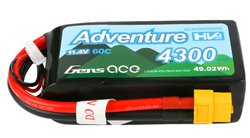 High voltage LiHV 3S Battery has a nominal voltage of 11.4V and maximum charged voltage of 13.05V.
High voltage LiHV 3S Battery has a nominal voltage of 11.4V and maximum charged voltage of 13.05V.One caveat to this I should mention are the new generation of "high voltage" (LiHV) LiPo cells / batteries.
There are several LiPo manufacturers that are producing LiPo cells that can be charged as high as 4.35 volts (3.80V nominal) safely while maintaining a 500 cycle life (in ideal lab conditions).
Just keep that in mind as I'll be covering conventional LiPo cell voltage charge numbers in this article, but the exact same principles apply to LiHV packs. You'll just sellect a higher termination voltage if you charger doesn't have a specific LiHV charge program built in that selects the higher voltage automatically.
Regardless, it is critical that you select the correct voltage or cell count when charging your RC LiPo batteries.
If you have a 2 cell (2S) LiPo pack you must select 7.4 volts or 2 cells on your charger. If you selected 11.1V (a 3S pack) by mistake and tried to charge your 2S pack, the pack will puff up, be destroyed and could even catch fire. Luckily, all the better computerized chargers out there these days will warn you if you selected the wrong cell count. I've been saved by that feature countless times when rushing.
All LiPo battery chargers will use the constant current / constant voltage charging method (cc/cv). All this means is that a constant current is applied to the battery during the first part of the charge cycle.
As the battery voltage closes in on 95% charge voltage, the charger will automatically start reducing the charge current and then apply a constant voltage for the remaining phase of the charge cycle.
The charger will stop charging when the 100% charge voltage of the battery pack equalizes with chargers constant voltage setting (usually 4.2 volts per cell) at this time, the charge cycle is completed. Going past that to 4.3 volts will shorten battery life substantially as we have already seen.
Maximum Safe Charging Current When Charging RC LiPo Batteries: 1C
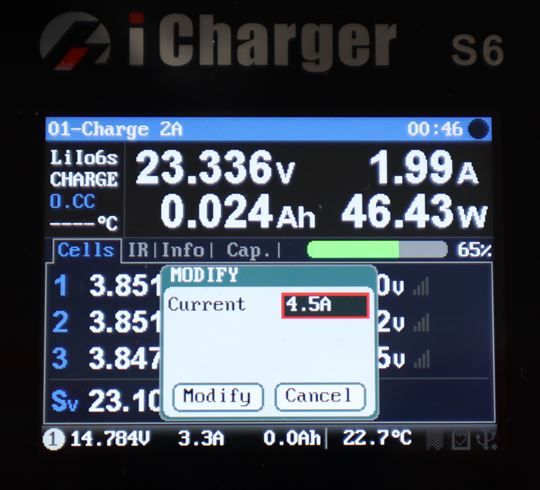 Selecting The Correct RC LiPo Battery Current. 1C Is ALWAYS Recommended. Here I'm charging 4500mAh pack, so I'm setting my charging current to 4.5 Amps.
Selecting The Correct RC LiPo Battery Current. 1C Is ALWAYS Recommended. Here I'm charging 4500mAh pack, so I'm setting my charging current to 4.5 Amps.Selecting the correct charge current is also critical when charging RC LiPo batteries. The golden rule here remains to be "never charge a LiPo, LiHV, LiIon, or LiFe pack greater than 1 times its capacity (1C)."
Battery voltage / cell count has no impact on charge current.
Regardless if the 4500 mAh example battery in the photo above was a 1S, 2S, or what it actually is, 6S; if charged at a 1C charge rate, all would be set to 4.5 Amps (4500 mA).
Going higher than a 1C charge rate will shorten the life of the pack.
Moreover, if I was to charge this LiPo battery at a significantly higher than the 1C value, say an order of magnitude 10C (45 Amps), the battery would heat up, likely puff up, and may even start on fire.
Charging Current Dictates Charging Speed.
Charge current will dictate how fast your battery pack charges. If you want faster charging, you increase the charge current. Again, for best battery life, 1C or under is recommended, but with good quality LiPo packs, you can go higher if you value charging speed over battery life.
Incidentally, a 1C charge rate will generally fully charge an 80% discharged LiPo in about an hour. A 50% storage state LiPo will be fully charge at 1C in about 30 minutes.
Yes, higher than 1C charge rates are possible if you want to charge even faster.
Most LiPo manufacturers I've contacted say you can safely charge at 2C on quality packs that have a discharge rating of at least 25C or more and have low internal resistances, but it will reduce LiPo life.
Even though there are more and more LiPo packs showing up stating 2C, 3C, 4C and even 5C charge rates; this is just indicating it's still safe to charge at those rates and not risk thermal runaway within the battery; but it has nothing to do with what's healthy.
The simple fact is constantly charging any LiPo over 1C will have a negative impact on its life expectancy.
I will charge at higher than 1C rates on occasion when I'm in a rush to get out to the field or want to get into the air again quickly; but I always try to charge at 1C or even lower rates most of the time. 0.5C would be even better for the packs.
It all boils down to speed vs. life. If you don't mind taking some life out of your packs in favor of getting back in the air or out on the track ASAP, then charging at higher C rates is a viable compromise.
I would however strongly recommend never charging over 1C if the ambient air temperature (and the pack) is over 30C (about 90F) or under 10C (about 50F). This was covered on the LiPo Battery Page, but it's worth mentioning again. The eight main things that shorten LiPo battery life are:
- HEAT
- LEAVING A LIPO FULLY CHARGED FOR SEVERAL DAYS
- OVER DISCHARGING (voltage & current)
- OVER CHARGING (voltage & current)
- INADEQUATE BALANCING
- IMPROPER STORAGE VOLTAGE
- TOO HIGH STORAGE TEMPERATURE
- PHYSICAL DAMAGE (dropping, over tightening straps, prying cells apart, using too much/too strong Velcro etc.)
Charging RC LiPo Batteries With Balancer
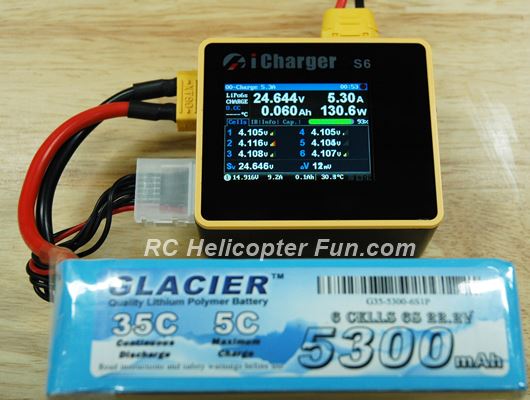 RC LiPo Battery Charging & Balancing
RC LiPo Battery Charging & BalancingI cover LiPo Battery Balancing in detail on my LiPo balancing page, but just wanted to quickly touch on this since it's such an important topic when it comes to charging RC LiPo Batteries. The two are interconnected!
Again, please reference that LiPo balancing page if you don't know what balance charging is. Balancing doesn't change anything covered on this page in regards to charging RC LiPo batteries. The same voltage & current settings are used regardless.
The one important point I wanted to mention on this LiPo charging page is you only need to balance charge LiPo's if they have 2 cells (2S) or more hooked in series. If you are only charging 1 cell (1S) LiPo batteries, balancing is never done for the simple reason there is nothing to balance.
LiPo Battery Voltage State of Charge Capacity
This chart shows the relationship between LiPo battery open circuit (no load) voltage and the state of charge capacity (1S to 6S). Staying within the white region is the safe bet!
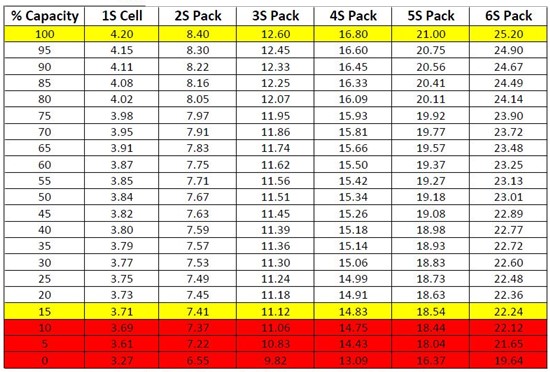 Never discharge a LiPo below 20% capacity! This is known as the 80% discharge rule that was covered on the LiPo battery page.
Never discharge a LiPo below 20% capacity! This is known as the 80% discharge rule that was covered on the LiPo battery page.How Long Can You Keep A LiPo In A Fully Charged State After Charging It?
I get this question alot, and my answer is always "as short a time frame as possible."
LiPo's are at their highest energy potential when fully charged meaning they are in their most dangerous state; so the less time they are sitting around fully charged, the better. But it goes beyond safety.
Fully charged LiPo's are not chemically happy! I have this mental image of them as a pressure tank with a bunch of angry electrons all crammed inside about to burst out.
I don't even like leaving my LiPo's fully charged overnight and always try to charge them within hours of heading out to the flying field; of course, that sometimes is not possible or practical. The weather might turn ugly, life might get in the way, any number of things may occur putting off my and your RC flying, driving or boating plans. So now what?
After my own experiences, researching lots of data and talking to others, it's fairly well established that fully charged LiPo battery degradation like most LiPo battery damage is an additive process just like normal usage is. So every hour your LiPo's are in a fully charged state, you are nibbling away some of their fully life span.
Certainly keeping them fully charged for a few days after charging is not going to do much long term damage, but overtime if that's a regular occurrence, those few days each time will start adding up to many weeks of your packs sitting in a fully charged state. Noticeable degradation will have occurred, be that increased internal resistance, capacity loss, or even minor puffing/swelling.
So, should you discharge them right away that same day if your RC plans are kyboshed?
Well, it depends. If you know you can likely get out tomorrow or even the next day for some RC fun, it's likely best from a cost / benefit ratio to leave them fully charged. Remember, discharging and charging back up is also nibbling away some LiPo life.
If however it's Sunday and you know for a fact you won't be flying, driving, or boating until next weekend, then I would certainly discharge them back to their storage state.
So, if your packs are sitting for two or three days fully charged don't sweat it, but don't make a habit of it if you want maximum life out of your RC LiPo batteries.
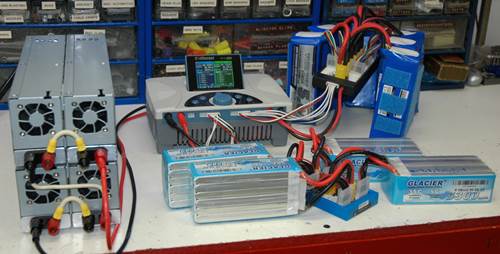 Charging a bunch of my RC LiPo batteries at once with a powerful RC charger. 80 Amps & 2000 Watts of Charging Fun!
Charging a bunch of my RC LiPo batteries at once with a powerful RC charger. 80 Amps & 2000 Watts of Charging Fun!







